Audinst is the sub-brand of Audio Instruments Solution, a Korean brand created in 2009.
Like the numerous growing companies riding the wave of on-the-move digital music listening, Audinst?s business proposition is rather subdued. Its catalogue only includes four devices: three convertors with amplifiers for headphones (HUD-mx1, HUD-mx2 et HUD-mini), and an autonomous amplifier model for headphones (Amp-HP), which includes a battery that boosts the sound of a smartphone or an audio player.
Today we will present you with the test bank for the HUD-mx2 DAC, which contains an asynchronized input for USB B 24 bit/96kHz to be used with computers (or smartphones or iPhones with ad hoc adaptors), as well as a S/PDIF optical 24-Bit/192kHz input.
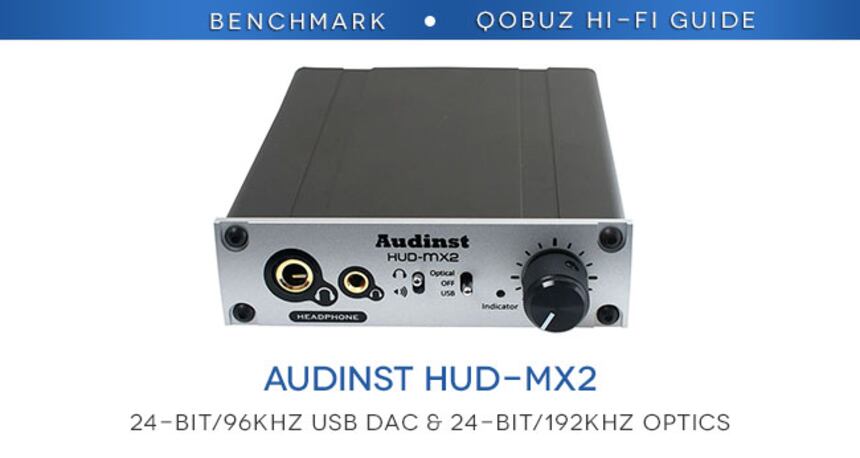
About the Audinst HUD-mx2 DAC
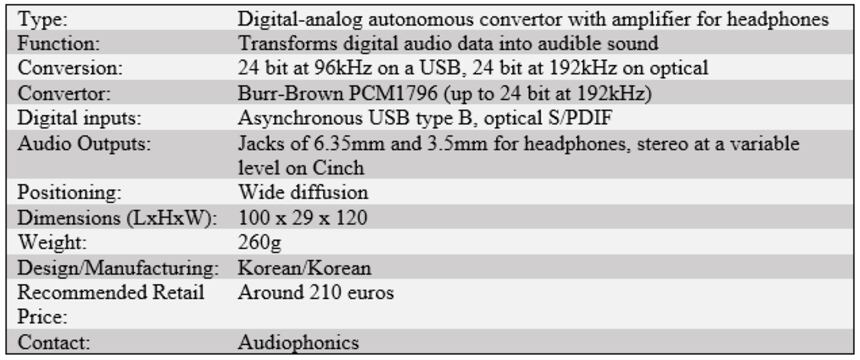
Presentation
The design of the Audinst HU-mx2 convertor prioritizes functionality and easily identifiable features, possessing an aluminium frame whose front face is clearly stamped with the brand logo.

Headphone adaptors are not needed, as two Jack sockets of 6.35mm and 3.5mm provided. One can even can connect two headphones at the same time, and you can control their volume using the non-sliding volume dial, which has a thick white indicator line.
A reverser switch enables you to direct the signal towards the headphone outputs or towards the line output situated on the back face. Similarly one can choose between the USB input, the optical input or no inputs at all, by using the switch on the front face.
A three-coloured LED light indicates the state of the DAC. The light is red when the device is on standby mode, orange when the DAC is attached to a computer, and green when it is decoding a digital audio file.
Connectivity
You can connect a computer using the asynchronous USB output, which is also OTG, and can thus be attached to a smartphone using a USB-OTG adaptor, or an iPad with the camera set. This output accepts signals up to 24 bit at 96kHz, which can be recovered in S/PDIF with the optical output. The optical input, on the other hand, is compatible with signals up to 24-Bit at 192kHz.

The audio outputs on Cinch, whose levels can be adjusted via the potentiometer on the front panel, can be connected to: a power amplifier, an amplifier for speakers, or an integrated amplifier input line, provided that the volume is left at a fixed level.
Manufacturing
Encased in a cast solid aluminium box, a high performance single printed circuit board contains all the electrical components on one face.
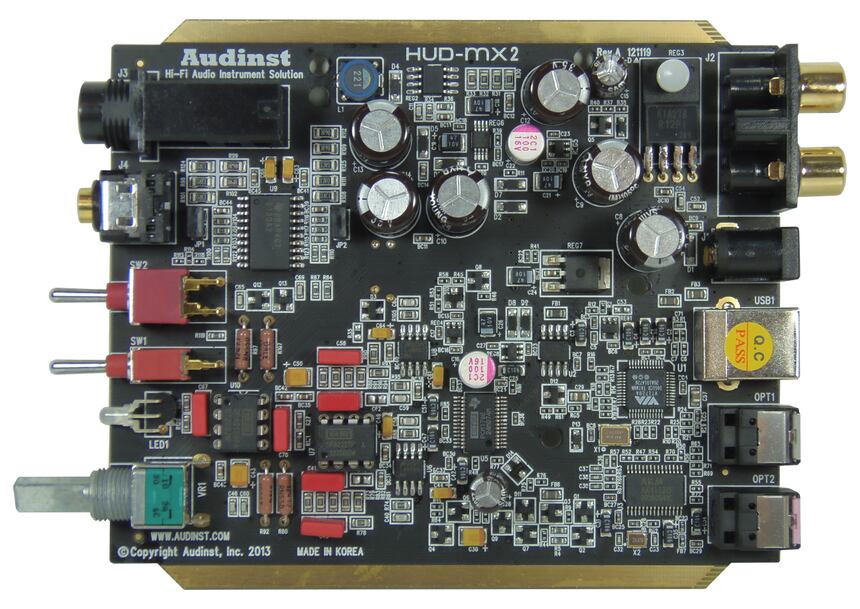
As for the power feed, the +15V voltage originating from the power supply united is filtered by a condenser of 330 ?F/35V. It is then stabilized at +12V by a KIA278R12PI regulator, from the Korean manufacturer KEC.
The regulator contains a deactivation switch that is triggered when you connect the mains adaptor after having connected the USB, which is contrary to the normal procedure. This activates the DAC?s circuit protection, even when the adaptor is unplugged when the DAC is working. This deactivation is also triggered when the connected computer is turned off, putting the DAC into energy saving mode.
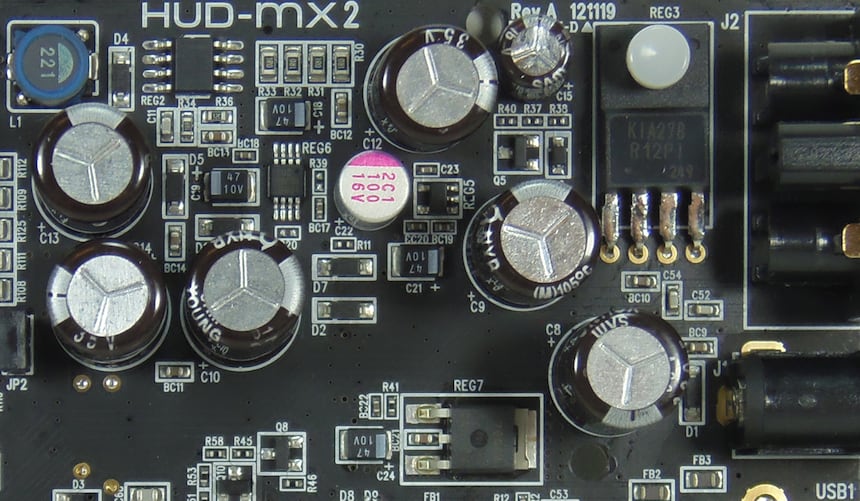
There are also two DC-DC convertors. The first is the MC33063 by ON Semiconductor, which generates - 12V or + 12V. This powers the operational amplifiers and the amplifiers for headphones, using symmetrical tensions of + or ? 12V when the power supply is connected. The second convertor is a Sipex SP6661, that produces -4V when the DAC is solely powered by the USB, reducing the symmetrical voltages to + or ? 4V.
The USB interface uses a VIA VT1728A circuit, that works in an asynchronous mode with digital signals up to 24 bit at 96kHz. The VT1728A chip also creates S/PDIF signals available on the optical output, whereas signals arriving via the optical input are supported by a (DIR) Asahi Kasei AK4113 digital receptor, that accepts signals up to 24 bit at 192kHz.
On the top left of the image below one can see the SST25VF512 Silicon Storage Technology flash memory.
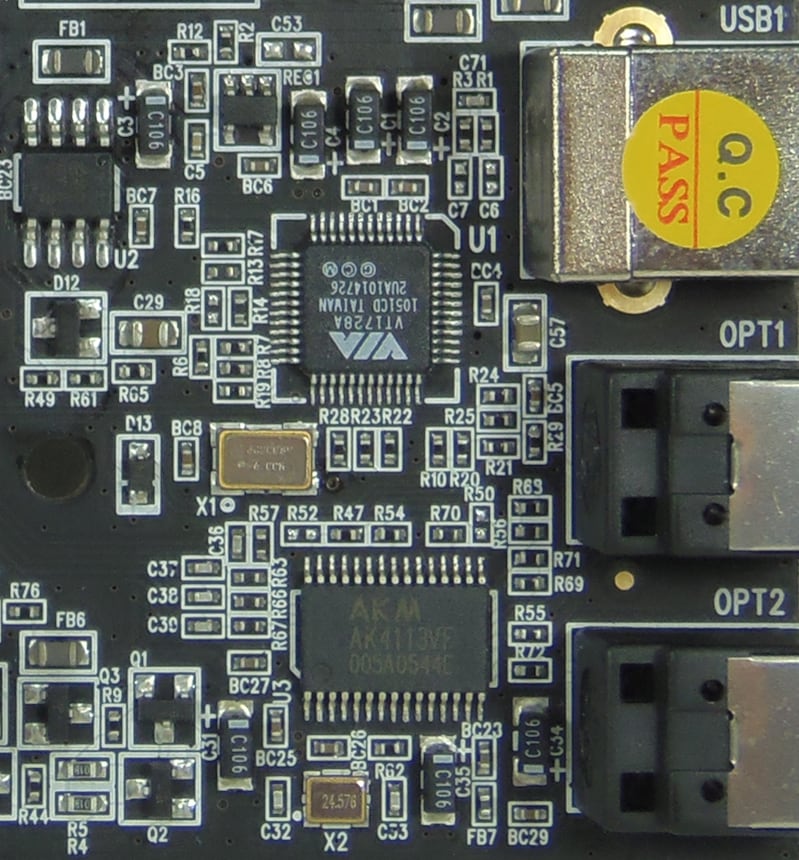
The device uses a PCM1796 Burr-Brown chip (24 bit at 192kHz), which ensures the digital analog conversion. The signals from the differential current outputs are transformed into voltages by the Texas Instruments LME49860 high performance operational amplifiers.
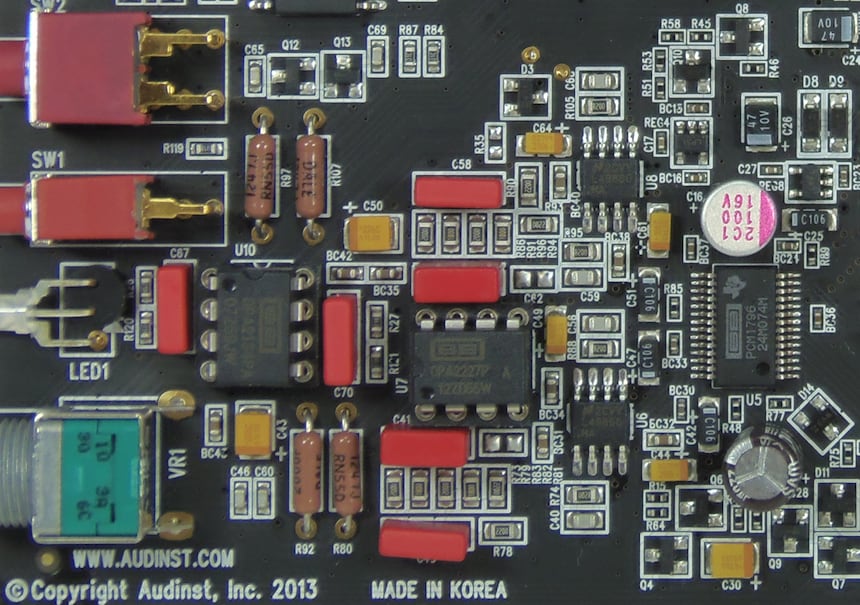
The active filtration is built around the Burr-Brown OPA227 operational ultra-low noise amplifiers with resistance to low tolerance, and the highly recommended Wima plastic dialectic condensers.
The device also contains a stage preamplifier using an OPA2134 operational amplifier, also from the Burr-Brown brand, as well as Vishay Dale low tolerance and high stability resistors.
These OPA2227 and OPA2134 models are enclosed in a classic 8-pin box (DIL8) and are mounted on a support.
The Alps potentiometer enables you to control the signal level sent to the amplifier for headphones, (a TPA6120A2 model by Texas Instruments). The gain can be increased by removing the two clips located at its sides, in cases where the headphones have an impedance superior to 300 ?, or if the volume is simply insufficient.
Listening
The Audinst HUD-mx2 DAC offered a hauntingly beautiful sound rendition when I listened via headphones to the Fantaisie Ecossaise by Max Bruch in the remastered version of 24 bit at 96kHz, in the version with Rudolf Kempe at the head of the Royal Philharmonic Orchestra and Kyung Wha Chung on the violin.
The sound rendition of the original analogical recording is extremely gentle, with the orchestra providing a gorgeous richness and the solo violin floating on top.
Dixit Dominus, Vivaldi?s eponymous work played by the Concerto Italiano and directed by Rinaldo Alessandrini (Studio Masters 24 bit at 44.1kHz), offers a beautiful and warm sound restitution, whose ardour expresses itself with conviction and sweetness.
The world-famous Another Brick In The Wall from the album The Wall by Pink Floyd is pleasingly reproduced, with the children?s voices retaining their colour without being shrill. However, others prefer the album to have a somewhat punchier bite.
However the Audinst HUD-mx2 DAC outshines itself when playing The Upsetter or I?m Aquarias from Metronomy?s album Love Letters. The sound reproduction is simply mind blowing, transporting the listener to cloud nine. Incredible.
It is a pleasure to listen to the 80s hit Don?t Answer Me from the album Ammonia Avenue by the band The Alan Parsons Project. The track is extremely delicate with fluid guitar chords, a deep yet unobtrusive bass, and voices that don?t monopolise center stage.
To conclude, the Audinst HUD-mx2 DAC is a device with a very professional concept and design. It offers a very pleasant sound reproduction that is touched with a certain sweetness, although this is better suited to some musical genres more than others.
Audiophonics website (Distributor)
Reading Capabilities
Audinst HUD-mx2

If you are a manufacturer, importer, distributor or actor in the domain of sound reproduction and you wish to contact us, please do so using the following address: newstech@qobuz.com
If you are passionate about our Hi-Fi Guide and you wish to contact us, please do so using the following address: rubriquehifi@qobuz.com



